Automatic Customs data exchange: a look into the system used in the Western Balkans
21 February 2024
By the Customs Administration of SerbiaCustoms administrations in the Western Balkans have established a platform to automatically exchange Customs data. Called “SEED”, the system has proven efficient in identifying irregularities, offences and smuggling activities, as well as in accelerating the clearance of goods.
With the support of the European Union, an IT system enabling systematic and automatic exchange of Customs data between Customs authorities of the Western Balkans has been established. This data relates to import, export and transit declarations, TIR and ATA carnets, and movements of empty trucks, as well as other documents requested under simplified procedures, such as invoices.
Called “SEED”, the system enables the administrations to receive pre-arrival data from the moment the Customs procedure starts in the Customs office of departure, and to verify the consistency of declarations submitted to the Customs offices of exit and entry.
SEED is a decentralized system (see Figure 1), composed of seven nodes: one located in each administration IT system and another one in the premises of Italian Customs in Rome. Each SEED node is composed of a SEED application server, which itself is connected to the Customs administration’s declaration processing system (Customs Declaration Processing System – CDPS). Data exchange links between the nodes are established via the public internet using virtual private networks (VPN).
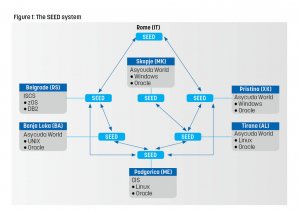
The legal base framing such exchanges was established through the signature of bilateral Protocols (MoUs) between each Customs administration. The latter also adopted operational guidelines and instructions for the use and management of the SEED system. Additionally, national implementing provisions were developed and published in the official rule books related to the fulfilment of Customs declarations.
Modules
The SEED application consists of several modules (see Figure 2) which extract data from the Parties’ CDPS. Data records are displayed in one window and can be searched, sorted by column, grouped, and exported in various formats. The main modules are presented below.
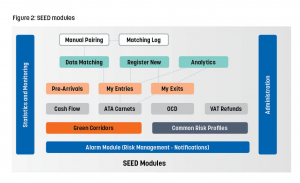
Pre-arrival Views
This module displays pre-arrival messages generated at the Customs office of exit when a Customs document is registered. Each administration has two “views”:
- “My Pre-arrival Views”: shows the set of records (announcements) generated by the administration for the cargo leaving its Customs territory and sent to the neighbouring Customs administrations.
- “Your Pre-arrival Views”: shows the set of records generated by a neighbouring Customs administration for the cargo destined for the Customs territory of the administration.
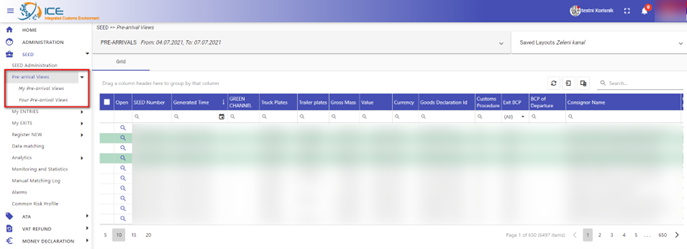
My ENTRIES
This module deals with two categories of records related to procedures applying to incoming traffic:
- My ENTRIES: all cargo entries at the crossing points of the administration’s Customs territory.
- Your EXITS: all cargo exits from neighbouring Customs administrations.
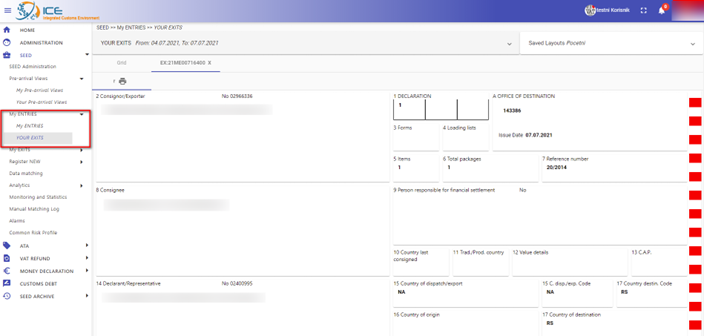
My EXITS
This module deals with two categories of records related to procedures applying to outgoing traffic:
- My EXITS: all cargo exits at the crossing points of the administration’s Customs territory.
- Your ENTRIES: all cargo entries from neighbouring Customs administrations.
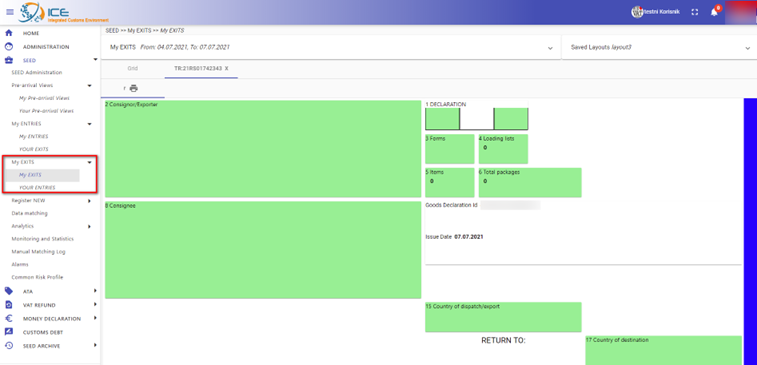
Register NEW
This module enables an administration to manually fill in records which are missing from the CDPS, at entry and exit levels. There are five sub-modules containing their own data entry form, which administrations can customize according to their needs:
- Entry/Exit under simplified procedures.
- Entry/Exit of full means of transport, both for road and railway traffic.
- Entry/Exit of empty vehicle.
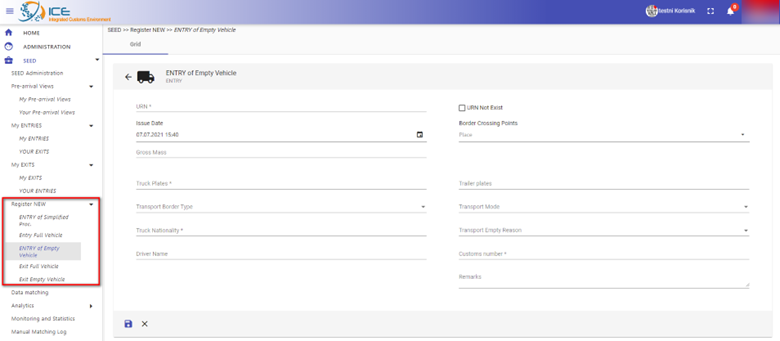
Data matching
This is one of the most advanced SEED modules. Using a colour system, it presents results of data pairing and matching at the entrance to a Customs territory:
- Green – matched records.
- Blue and Yellow – matched within the configured tolerance range.
- White – there are no matching records because of the nature of the procedure (for example, for the import of used vehicles, there is no record at exit from the neighbouring Customs. Under the inward processing procedure, only the added value of goods is declared at export, while the total value would be declared at import).
- Red – no matched records.
The main grid shows all records which have at least one “paired” record. The total number of “single unpaired” records is shown in the same window.
The grid functionalities include currency conversion, manual pairing, and a light algorithm[1], etc. Manual pairing enables authorized officers to manually connect/pair or disconnect/un-pair records. However, data itself and data comparison/matching cannot be manipulated.
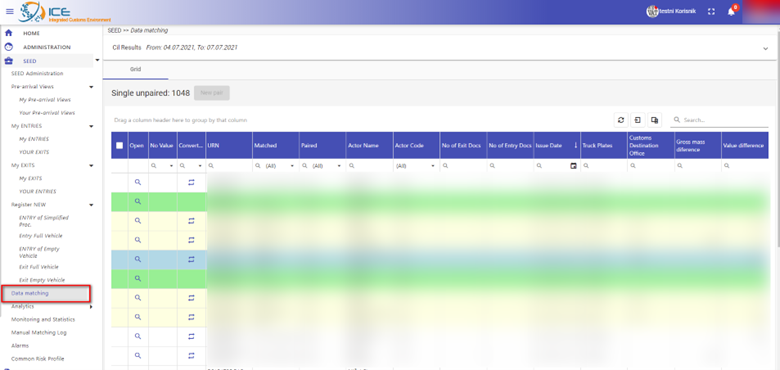
Analytics
This module enables officers to easily visualize data and to conduct a detailed analysis of exchanged records. It can display one or all four groups of messages (my entries, my exits, your exits, your entries) for a given time. As they are able to see all the data in a single place, supported by advanced analytic functions, officers can identify unusual or risky movements. A typical example is the subsequent exit/entry of empty vehicles.
Monitoring & Statistics
This module creates a graphical representation of data for a selected period of time. The data is related to:
- Received messages,
- Sent messages,
- Matching statistics,
- Error messages.
All created graphical representations can be converted into different file types (PNG, JPEG, PDF, and SVG).
Matching Log
This module generates a log of all the records which were paired manually by authorized users. Users can directly access the documents related to the records.
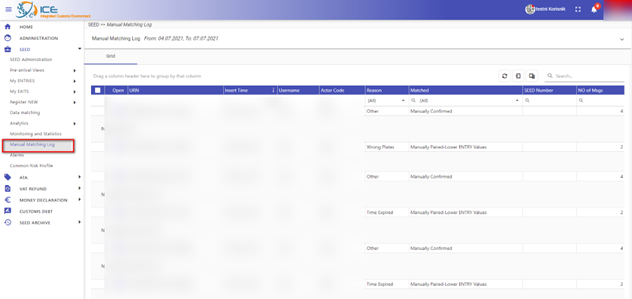
Alarms
This is one of the most advanced features of the SEED. It enables authorized users to create and manage risk profiles to be applied to pre-arrival messages for transit, export, simplified procedures and TIR. A “tracking functionality” enables officers to monitor shipments along the various steps of a clearance procedure.
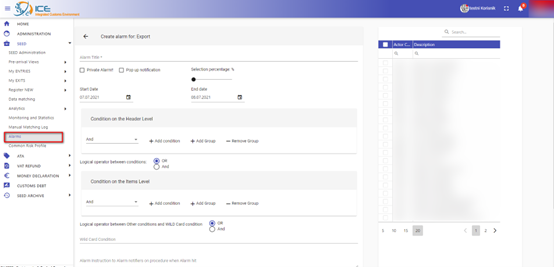
Common Risk Profiles
Common Risk Profiles are integrated into the SEED. They are developed according to the following method:
- An analysis of regional risks is conducted,
- One party proposes creating a profile,
- The relevance of the proposal is discussed,
- If deemed relevant, the profile is applied by all parties to the system during a given period,
- Data on the number of hits/controls and detections related to the risk profile is analysed,
- The profile is endorsed or rejected.
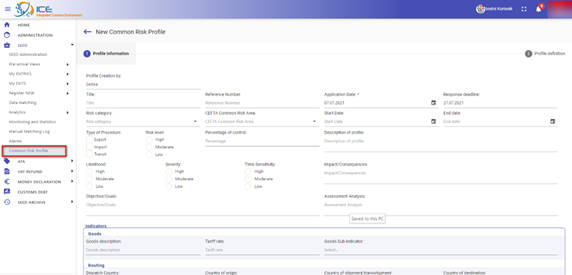
ATA carnets
The ATA carnet is an international Customs document that permits duty-free and tax-free temporary admission of most goods for up to one year. It enables countries, businesses and border agencies to expedite the Customs process by utilizing unified, ready-to-use declaration forms and eliminating the lodging of a guarantee, bond or cash deposit in the country of temporary importation.
The SEED ATA carnets module supports the entire lifecycle of all types of carnets within a Customs territory:
- Temporary Exports (yellow carnets),
- Temporary Imports (white carnets),
- Transits (blue carnets).
When a paper carnet is issued by a Chamber of Commerce, it is also created electronically in the SEED. When a carnet is presented at a crossing point of exit, a Customs officer registers the operation (for example, temporary export) in the SEED national ATA module. A message is then automatically created and sent to the neighbouring Customs administration.
VAT refund
Fraud related to VAT refunds is common in the Balkans region. Foreign individuals buying goods in one Customs territory ask for a VAT refund when exiting it, but fail to declare the goods when entering the other Customs territory. Such undeclared goods are relatively small in size (watches, mobile devices, etc.).
The SEED VAT refund module enables Customs officers to register requests for VAT refunds at the exit point and to share the information about the transaction with the next Customs point of entry. As with all other SEED modules, it displays all requests registered at the national level and by other parties, and keeps records of rejected requests.
Cash declarations
All travellers entering or leaving the European Union’s territory are obliged to complete a cash declaration when carrying 10 000 euro or more (or the equivalent in other currencies, bonds, shares, traveller’s cheques, and valuable items). Customs authorities are empowered to check persons, their luggage and their means of transport. They are also empowered to detain undeclared cash. The same rules apply in most SEED Customs territories.
The Cash declarations module enables Customs officers to enter data both on cash declarations, and seizures of non-declared cash. It provides for a front-end module which allows passengers to make a declaration even before arriving at the crossing point. Data related to the declarations is automatically shared between SEED users.
Historical perspective
The SEED system was developed and upgraded in stages.
In 2002, the European Commission established a Customs and Fiscal Assistance Office (CAFAO) Programme to the Western Balkans to assist the Customs and taxation authorities in their preparation for future EU membership.
Under the CAFAO Programme, different data exchange systems were tested. The most successful ones, which are considered predecessors of the SEED, were:
- The Danube River Early Warning System (DREWS), a tool for the exchange of data on vessels and cargo on the Danube River between Hungary, Croatia and Serbia, and
- The Southeast Europe Messaging System (SEMS) – a tool for electronic exchange of intelligence.
Following the success of the above systems, when the CAFAO Programme was about to end in late 2007, the European Commission decided to provide funding to test the use of the SEMS to establish the systematic electronic exchange of data related to Customs declarations between Western Balkans Customs authorities. The pilot was a success and work was started to develop a fully-fledged application covering the entire region. SEED was born. Three consecutive maintenance projects were conducted over the years to keep the system up and running.
SEED+
During the COVID-19 pandemic crisis, the SEED system was used to enable exchange of pre-arrival information on cargo transported by trucks along specific corridors and consisting of “essential goods”, between Customs administrations and phytosanitary, veterinary and sanitary authorities involved in the clearance of goods. The list of goods considered as essential was agreed between Parties to the Central European Free Trade Agreement (CEFTA) at HS8 level.
The idea that SEED could be developed to enable systematic data and document exchange between numerous stakeholders, in addition to Customs authorities, attracted the interest of the CEFTA Secretariat, which has the ambitious task of eliminating administrative barriers to trade in the region. As some of the CEFTA Parties are not WTO members, the Trade Facilitation Agreement is not directly applicable to them. In view of this, CEFTA designed a special instrument, the Protocol on Trade Facilitation (CEFTA Additional Protocol 5). An upgraded version of SEED, called “SEED+”, was to be instrumental in the implementation of Protocol 5.
The SEED+ project is fully funded by the European Union and implemented jointly by the CEFTA Secretariat and the Italian Customs and Monopolies Agency. It encompasses two main traits:
- Development of the CEFTA TRACES New Technologies platform, based on the EU TRACES NT platform (the European Commission’s online platform for sanitary and phytosanitary certification required for the importation of animals, animal products, food and feed of non-animal origin and plants into the European Union, and the intra-EU trade and EU exports of animals and certain animal products). CEFTA TRACES NT will enable the management of online certification and notifications of information on non-compliant consignments for animals and goods.
- Upgrade of current SEED to Customs SEED+ by establishing additional data exchange links, upgrading Customs SEED modules and improving regional Customs risk management.
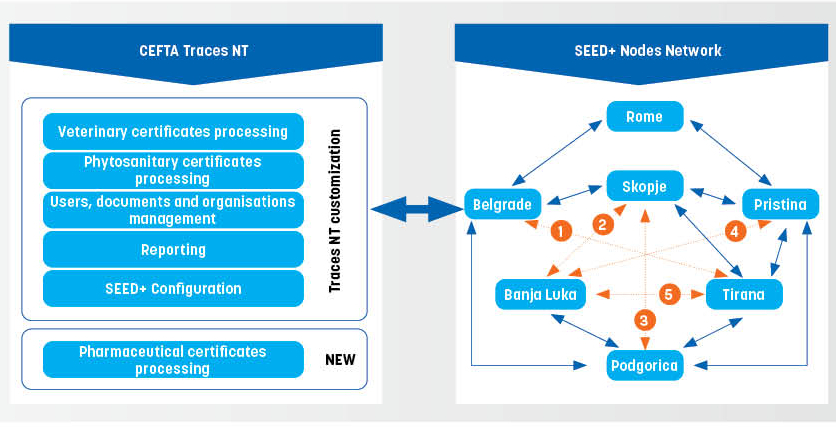
Green Corridors
Green Corridors/Lanes were established at the start of the COVID-19 outbreak in order to prevent shortages of essential goods. At the Sofia Summit held in November 2020, the leaders of the Western Balkans expressed their support for extending the system established at Green Corridors/Lanes to all Border Crossing Points (BCPs) and Common Crossing Points (CCPs) in the Western Balkans.
Thanks to pre-arrival exchange of information between regulatory agencies, documentary checks can be conducted before the essential goods arrive at the Crossing Points, and inspections (when required) can be organized more efficiently. As a result, transporters carrying essential goods can be given priority passage throughout the Western Balkans.
Data from SEED is used for the creation of statistics, such as number of trucks, declarations, and types of items in consignments, as well as Customs-to-Customs waiting times. The information is published at https://greencorridors.cefta.int. As one can see, the clearance of essential goods takes longer than that of non-essential goods as such goods require the issuing of permits by technical agencies (primarily, phytosanitary and veterinary agencies). However, from 2021 to 2023, the average waiting time for all BCPs/CCPs has decreased (see Table 1).
Table 1 – Average waiting time for all BCPs/CCPs from 2021 to 2023
| Average time without empty trucks (in minutes) | Average time including empty trucks (in minutes) | YEAR |
| 108.79 | 96.32 | 2021 |
| 103.12 | 93.13 | 2022 |
| 94.55 | 85.48 | 2023 |
Electronic exchange of data with the EU
Unilateral electronic exchange of data was established between Western Balkans Customs territories and EU countries as follows:
- North Macedonia and Greece,
- Albania, Montenegro and Italy,
- Montenegro, Bosnia, and Croatia.
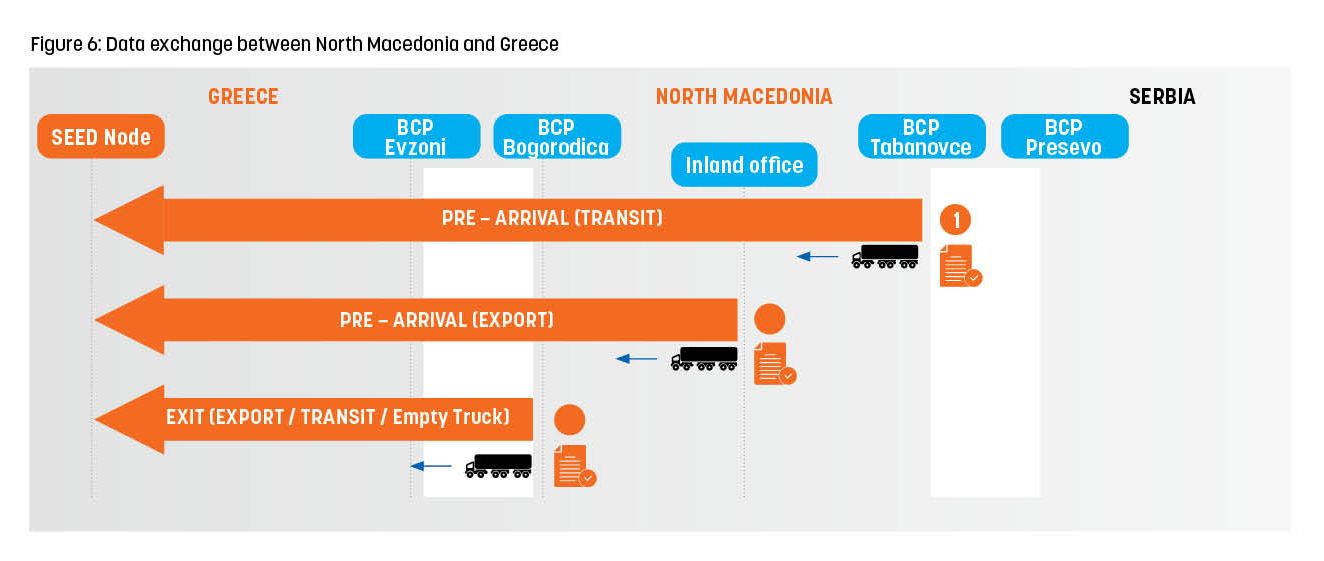
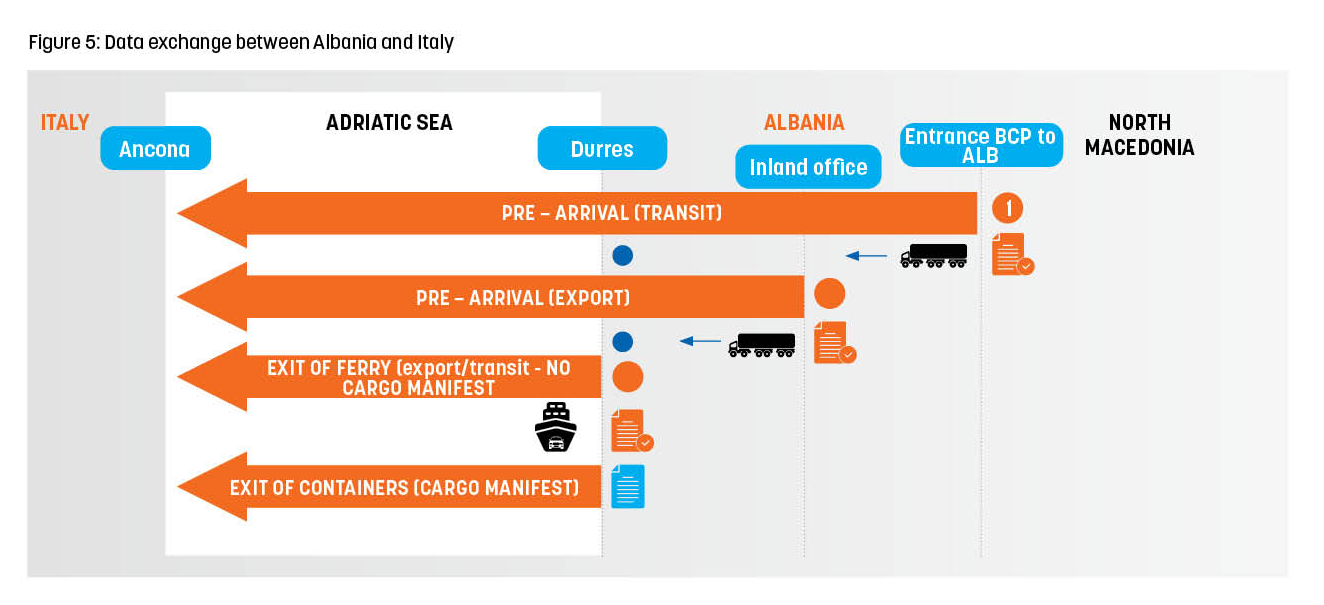
Data exchange is unilateral as EU regulations prohibit systematic exchange of Customs data from EU Member States to other countries. The type of data exchanged is illustrated in Figures 5 and 6.
The EU is also testing the use of the SEED+ system in the countries of the Eastern Partnership, a European Commission initiative which aims to strengthen and deepen the political and economic relations between six Eastern European and South Caucasus countries (Armenia, Azerbaijan, Belarus, Georgia, Moldova and Ukraine).
The SEED+ system has been piloted for data exchanges between:
- Lithuania – Belarus (empty trucks, limited data set, full data set for volunteers).
- Ukraine – Romania (empty trucks).
- Moldova – Romania (empty trucks).
Conclusion
SEED has evolved into a powerful tool for Customs administrations in the Western Balkans and beyond, contributing to the fight against smuggling and undervaluation, and significantly reducing the time required to clear goods. SEED’s continued development and expansion promise to further enhance the management of the movement of goods in the region and beyond.
More information
medjunarodnoEU@carina.rs
[1] A light algorithm is a matching algorithm which does not take the invoice value as a relevant parameter for data matching. This algorithm needs to be applied in cases when Customs documents do not contain information about the invoice value.


